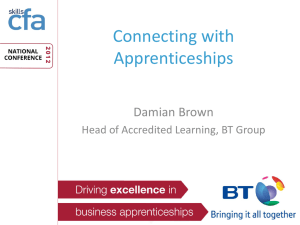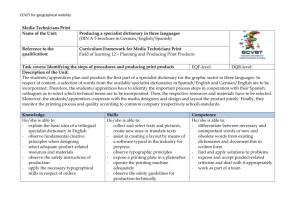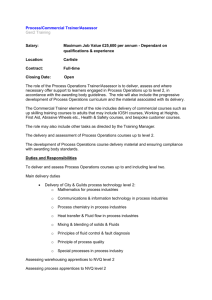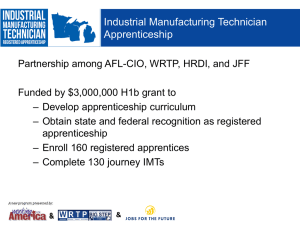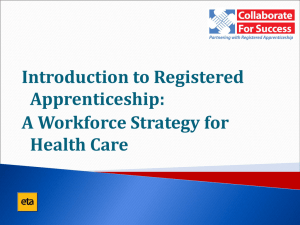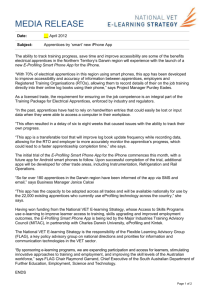Dimensions Training Solutions Limited
advertisement
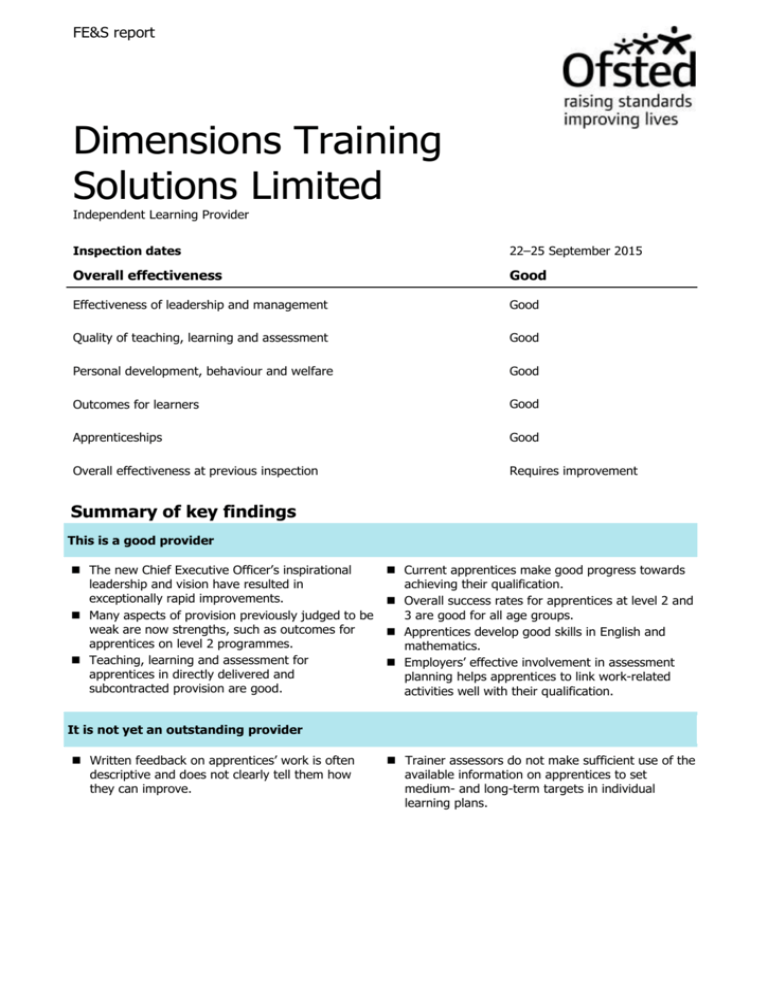
FE&S report Dimensions Training Solutions Limited Independent Learning Provider Inspection dates 22–25 September 2015 Overall effectiveness Good Effectiveness of leadership and management Good Quality of teaching, learning and assessment Good Personal development, behaviour and welfare Good Outcomes for learners Good Apprenticeships Good Overall effectiveness at previous inspection Requires improvement Summary of key findings This is a good provider The new Chief Executive Officer’s inspirational Current apprentices make good progress towards leadership and vision have resulted in achieving their qualification. exceptionally rapid improvements. Overall success rates for apprentices at level 2 and Many aspects of provision previously judged to be 3 are good for all age groups. weak are now strengths, such as outcomes for Apprentices develop good skills in English and apprentices on level 2 programmes. mathematics. Teaching, learning and assessment for Employers’ effective involvement in assessment apprentices in directly delivered and planning helps apprentices to link work-related subcontracted provision are good. activities well with their qualification. It is not yet an outstanding provider Written feedback on apprentices’ work is often descriptive and does not clearly tell them how they can improve. Trainer assessors do not make sufficient use of the available information on apprentices to set medium- and long-term targets in individual learning plans. Full report Information about the provider Dimensions Training Solutions (DTS) Limited is a privately owned company that has been operating since 1983, specialising in the provision of hairdressing apprenticeships. The current owners took over the company in early 2015. DTS has its head office in Barnsley, South Yorkshire, and learners work in salons, care settings and in small to medium-sized businesses across the county. DTS contracts with two other providers to deliver its business studies and health and social care apprenticeship provision. Publicly funded apprenticeship programmes account for approximately 90% of the company’s provision. Unemployment rates in the local area are slightly higher than the national rate. The proportion of students achieving five or more GCSEs at the end of Key Stage 4 is below the national rate. The proportion of residents from minority ethnic groups in the areas in which DTS operates varies between 2% in Barnsley to 19% in Leeds. What does the provider need to do to improve further? Ensure that trainer assessors provide evaluative written feedback on apprentices’ work that clearly identifies what they have done well and what they need to do to improve. Ensure that trainer assessors make better use of the available information on apprentices, such as that gathered during initial assessment, to set medium- and long-term targets in individual learning plans. Inspection Report: Dimensions Training Solutions Limited, 22–25 September 2015 Page 2 of 8 Inspection judgements Effectiveness of leadership and management is good Previous inspections of DTS have judged the company’s overall effectiveness either to be satisfactory or to require improvement. However, the new Chief Executive Officer’s inspirational leadership and clear strategic vision have resulted in exceptionally rapid improvements leading to good overall provision for the first time. Leaders and managers have a determined focus on the quality of provision and they have high expectations of all apprentices, as reflected in the robust monitoring and intervention arrangements, including in subcontracted provision. The Chief Executive Officer has carried out a management restructure that has clarified the roles of senior staff and of lines of accountability for all delivery staff. The implementation of particularly effective performance management arrangements, an integral feature of this restructure, has resulted in significant improvements in teaching and learning. The Chief Executive Officer has tackled successfully all of the key improvement areas identified at the last inspection. Many aspects of provision previously judged to be weak are now strengths, such as success rates for apprentices on intermediate programmes. A few recently introduced initiatives, such as the improvement of individual learning plans and the quality of written feedback on apprentices’ work, are yet to have a measurable impact. In response to feedback from local employers and to improve provision, DTS managers have successfully adapted the teaching model used by trainer assessors so that apprentices now receive individual training in the workplace rather than during group learning sessions at DTS’ training centre. This individualised approach to learning has resulted in trainer assessors focusing more carefully on each apprentice’s barriers to learning and on developing their ability to make a positive contribution in the workplace. Managers have greatly increased the amount and range of continuous professional development for staff, with sessions now taking place every two weeks. The schedule is well planned and matched to areas for development arising from observations of trainer assessors. Staff evaluations of these professional development activities are positive and the impact of the training is clearly evident in improved teaching and learning. Leaders and managers place a very high priority on developing apprentices’ English and mathematics skills. DTS’ functional skills tutor has developed a wide range of vocationally relevant resources that trainer assessors use effectively during training. Senior managers have accurately self-assessed the company’s key strengths and weaknesses. They use data well to support management decisions. Staff at all levels have a better understanding of management information and how to use data for monitoring performance, so that areas for improvement are promptly identified and effective interventions put into place. Staff work well with the Local Enterprise Partnership, community stakeholders and local employers to ensure that the provision offered meets the needs of apprentices and of employers. Apprentices are clear about their future plans and the skills and knowledge they need to achieve them. Senior leaders have an exceptionally clear and ambitious vison for the future of the company. They have well-considered plans for expanding the provision and securing additional funding streams based on a sound understanding of regional employment patterns and well matched to the available internal expertise in the company. The governance of the provider The directors of the company use their skills very effectively to support and challenge the Chief Executive Officer to maintain the company’s focus on quality and to drive rapid improvements. They have a clear vision for the company’s medium- and long-term future goals and what they and the Chief Executive Officer have to do to achieve those goals. The arrangements for safeguarding are effective Arrangements for safeguarding are effective and DTS carries out appropriate checks on staff and workplaces. Apprentices feel safe and know who to contact if they feel vulnerable or threatened. Detailed safeguarding procedures are in place and case studies show that actions taken to address causes for concern are effective. Inspection Report: Dimensions Training Solutions Limited, 22–25 September 2015 Page 3 of 8 Quality of teaching, learning and assessment is good Teaching, learning and assessment for apprentices in directly delivered and subcontracted provision in hairdressing, health and social care and administration are good. Apprentices enjoy their learning. Individual coaching in the workplace is particularly effective in hairdressing. Well-qualified and experienced trainer assessors use their subject expertise well to plan individual coaching sessions that motivate and interest apprentices effectively and help them to make good progress. As a consequence, hairdressing apprentices can skilfully and confidently demonstrate a range of techniques such as hair colouring, mixing bleach and foil techniques. Trainer assessors assess learning effectively using good questioning techniques and quizzes to check understanding and to consolidate and reinforce learning. Assessment is good and apprentices produce a wide range of evidence in their portfolios. Effective employer involvement in assessment planning helps learners to link work-related activities well with their qualification. Trainer assessors make good use of email to provide individual support for apprentices between sessions, which helps them to make good progress. Hairdressing apprentices work in good-quality salons with a diverse range of clients. This provides them with opportunities to develop their technical skills to good industry standard. Apprentices gain confidence in the workplace and quickly become valued team members. The good support provided by trainer assessors helps apprentices to develop communication skills effectively, such as by enabling hairdressing apprentices to confidently complete consultations with clients. Trainer assessors challenge and extend apprentices’ knowledge and understanding by providing them with good opportunities to develop skills beyond the level required for their qualification. The development of apprentices’ English and mathematics skills is highly effective. Trainer assessors use a good range of work-related activities during individual coaching sessions in the workplace. Specialist trainers provide additional coaching for apprentices with specific learning needs. Apprentices enjoy developing skills in the context of their work, such as learning about the meaning and correct application of technical terms and using their newly gained mathematics skills to calculate the cost of clients’ treatments. Apprentices benefit from a thorough introduction to equality and diversity at induction. Trainer assessors include relevant equality and diversity topics in coaching sessions and reviews. This helps apprentices to understand how these topics relate to their work, for example in subcontracted health and social care provision where apprentices participate in discussions about service user rights during the early onset of dementia. Initial assessment is robust and provides an accurate assessment of apprentices’ occupational skills and starting points for their English and mathematics. Apprentices receive a thorough induction session in their workplace, which helps them to prepare well for the demands of the apprenticeship programme. Trainer assessors provide impartial information, advice and guidance about future learning and career aspirations, which encourages apprentices at an early stage to plan for the next step in their learning. Trainer assessors set apprentices clear objectives at monthly reviews and the monitoring of their shortterm progress is effective. However, they do not always use the information gathered during initial assessment well enough to record medium- and long-term targets in individual learning plans to help apprentices to improve their work and reach their potential. Trainer assessors provide apprentices with constructive verbal feedback which helps them to improve their practice, for example when learning creative techniques using everyday objects, such as bendy rods and chopsticks, to curl clients’ hair. However, written feedback on apprentices’ work in directly delivered and in subcontracted provision is often too descriptive and does not identify clearly what learners have done well and what they need to do to improve. Personal development, behaviour and welfare are good Apprentices demonstrate a commitment to learning and ambition to do well in their chosen career. They talk confidently about their work in salons or in care settings and are making good progress towards achieving their qualification. Portfolios are well organised and apprentices take pride in presenting their work. Workplaces are of good quality, especially hairdressing salons. Apprentices work well with their employers and colleagues and dress appropriately for the workplace. Hairdressing salons have a mix of clientele and Inspection Report: Dimensions Training Solutions Limited, 22–25 September 2015 Page 4 of 8 hairdressing services that provide good opportunities for apprentices to develop a range of skills in cutting, applying colouring techniques, blow-drying, setting and perming. Apprentices develop workrelated skills such as teamworking and customer service. Information communication technology apprentices use formulae effectively when producing spreadsheets and PowerPoint well to design and deliver presentations. Hairdressing apprentices are confident and use good communication skills when carrying out consultations with clients. Apprentices enjoy the way that trainer assessors teach English and mathematics. They speak positively about the importance of improving these functional skills. The innovative teaching integrated with commercial practice, together with individualised support, meet the needs of apprentices very effectively. As a consequence, success rates in functional skills English and mathematics tests are high and apprentices apply these skills effectively in their work. Apprentices make good progress towards achieving their qualification. Many take additional qualifications that enhance their career prospects. Some salons provide apprentices with opportunities to learn about colour correction, creative styling and barbering. Intermediate apprentices on business programmes study additional advanced-level units to enhance their learning, knowledge and career options. Apprentices develop good skills matched well to their level and ability. Trainer assessors and employers work together to plan apprentices’ skill development and to identify any gaps so that they can arrange specific additional training if required. Employers speak positively about how the skills and confidence of their apprentices have improved. Apprentices observe health and safety practices in the workplace and trainer assessors regularly reinforce the importance of complying at all times with safe working practices. Learning resources on safeguarding, health and well-being, extremism and radicalisation are of high quality and easy to understand. Apprentices report that they feel safe at work and in the training centres. Apprentices develop independent learning skills and take responsibility for attendance and punctuality at work and at training and assessment sessions. Those on the hairdressing programmes conscientiously find their own models so that they can complete assessments promptly. Many are keen to accelerate their progress and move on to more complex hairdressing skills and treatments. Employers report that the support they receive from DTS staff in specific skills areas, such as blow-drying and complex hair extension work, has helped them to provide a better service to their clients. Outcomes for learners are good Most of DTS’ apprentices have a range of significant barriers to learning and a history of academic underachievement, especially in English and mathematics. A majority of current apprentices began their apprenticeship without having previously achieved GCSE grade A* to C in English and mathematics. However, trainer assessors skilfully provide individual support for these apprentices, leading to the large majority rapidly gaining skills in English and mathematics. As a consequence, the achievement of functional skills in English and mathematics at level 2 has increased significantly over the last year and is now well above national rates. Overall success rates for young apprentices at level 2 have risen rapidly and are now high. The proportion who complete within the planned period is also high. The company has maintained high overall success rates for apprentices at level 3 for all age groups. Apprentices perform well in business administration, hairdressing and health and social care, and those studying in subcontracted provision do as well as those in provision that DTS delivers directly. Few differences exist in the performance of different groups of apprentices. Managers have worked particularly hard to close the achievement gap for apprentices aged 16 to 18 at level 2, because this group had previously fared significantly worse than older apprentices at this level. Success rates for apprentices with additional learning needs have risen but remain slightly below that of apprentices without additional needs. DTS’ managers have taken swift and targeted actions to tackle this disparity, but it is too soon to judge the effectiveness of these measures. Trainer assessors prepare apprentices well for the next stage of their education, training or employment. The large majority of apprentices who completed their programme in 2015 gained permanent employment in an industry relevant to their apprenticeship. The remainder progressed into further education or training. The proportion of apprentices who achieve a promotion following their studies is particularly good. Inspection Report: Dimensions Training Solutions Limited, 22–25 September 2015 Page 5 of 8 Provider details Type of provider Independent learning provider Age range of learners 16+ Approximate number of all learners 141 over the previous full contract year Principal/CEO Suki Kalirai Website address www.dimensions-training-solutions.com Provider information at the time of the inspection Main course or learning programme level Total number of learners (excluding apprenticeships) Level 2 Level 1 or below Level 3 Level 4 and above 16–18 19+ 16–18 19+ 16–18 19+ 16–18 19+ 0 0 0 0 0 0 0 0 Intermediate Number of apprentices by apprenticeship level and age Advanced Higher 16–18 19+ 16–18 19+ 16–18 19+ 62 31 8 31 0 0 Number of traineeships 16–19 19+ Total 0 0 0 Number of learners aged 14–16 0 Funding received from Skills Funding Agency (SFA) At the time of inspection the provider contracts with the following main subcontractors: Excel Training Limited XTOL Training Services Limited Inspection Report: Dimensions Training Solutions Limited, 22–25 September 2015 Page 6 of 8 Information about this inspection Inspection team Jai Sharda, lead inspector Her Majesty’s Inspector Heather Barnett Her Majesty’s Inspector Maggie Fobister Ofsted Inspector Cathie Prest Ofsted Inspector The above team was assisted by the Chief Executive Officer as nominee, and carried out the inspection at short notice. Inspectors took account of the provider’s most recent self-assessment report and development plans, and the previous inspection report. Inspectors used group and individual interviews, telephone calls and online questionnaires to gather the views of students and employers; these views are reflected within the report. They observed learning sessions, assessments and progress reviews. The inspection took into account all relevant provision at the provider. Inspection Report: Dimensions Training Solutions Limited, 22–25 September 2015 Page 7 of 8 Any complaints about the inspection or the report should be made following the procedures set out in the guidance ‘Raising concerns and making complaints about Ofsted’, which is available from Ofsted’s website: www.ofsted.gov.uk. If you would like Ofsted to send you a copy of the guidance, please telephone 0300 123 4234, or email enquiries@ofsted.gov.uk. Learner View is a website where learners can tell Ofsted what they think about their college or provider. They can also see what other learners think about them too. To find out more go to www.learnerview.ofsted.gov.uk. Employer View is a new website where employers can tell Ofsted what they think about their employees’ college or provider. They can also see what other employers think about them too. To find out more go to www.employerview.ofsted.gov.uk. The Office for Standards in Education, Children's Services and Skills (Ofsted) regulates and inspects to achieve excellence in the care of children and young people, and in education and skills for learners of all ages. It regulates and inspects childcare and children's social care, and inspects the Children and Family Court Advisory and Support Service (Cafcass), schools, colleges, initial teacher training, further education and skills, adult and community learning, and education and training in prisons and other secure establishments. It assesses council children’s services, and inspects services for looked after children, safeguarding and child protection. If you would like a copy of this document in a different format, such as large print or Braille, please telephone 0300 123 1231, or email enquiries@ofsted.gov.uk. You may reuse this information (not including logos) free of charge in any format or medium, under the terms of the Open Government Licence. To view this licence, visit www.nationalarchives.gov.uk/doc/open-government-licence, write to the Information Policy Team, The National Archives, Kew, London TW9 4DU, or email: psi@nationalarchives.gsi.gov.uk. This publication is available at www.gov.uk/government/organisations/ofsted. Interested in our work? You can subscribe to our monthly newsletter for more information and updates: http://eepurl.com/iTrDn. Piccadilly Gate Store Street Manchester M1 2WD T: 0300 123 4234 Textphone: 0161 618 8524 E: enquiries@ofsted.gov.uk W: www.ofsted.gov.uk © Crown copyright 2015

